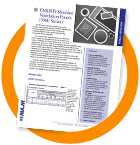When thinking about EMI/RFI connector gaskets, one of the best analogies might be in your own home, with water. Water can be a godsend or a curse. It needs to be contained in your plumbing system which takes it to where it is useful. But a leak within your home or from the outside elements causes serious problems. Now take that analogy up a notch. Think of connector gaskets as the protection, keeping signals where they need to be where ever there is a connection to a bulkhead. They stop stray EMI//RFI noise or “leaks” from causing problems. They seal, terminate or pass noise; from within an enclosure so EMI contamination doesn’t leak into surrounding components, and from the outside so your sensitive components can do what they are supposed to do without disruption.
Shielding Connector Gaskets Basic Construction
Drop back to our home analogy for just a second. In a storm, that screen door is definitely not waterproof. Rain can easily pass through the wire mesh. We’ve all seen the Flex Seal commercials on TV where the promoter places a screen door in the bottom of a boat. Naturally in that state it would leak and sink. But after he sprays his miracle product over the screen, the boat becomes waterproof enough to float. Your connector gaskets are built much the same way, only with a few additional considerations. For the most part a wire mesh is embedded in an environmentally friendly coating, both of which are selected for the environment and galvanic activity your product will need to withstand. The actual process results in a sheet of material which can then be die cut, flash cut or cut with a water jet to make the final gasket product.
EMI/RFI Connector Gasket Selection
In short, EMI/RFI connector gaskets have a important role at a number of connecting points. Fortunately there are a myriad of choices to plug your “leaks”, but use requires knowing the answers to several questions. The first should be, “To what standards are you building your hardened enclosure?” In other words, to what level of attenuation does your connector-to-bulkhead gasket need to perform; consumer/commercial or military/aerospace?
The next question has to do with the intended environment the gasket will live in. The answer to this will determine the type of elastomer material that will be used and whether it needs to be conductive or non-conductive. Two common elastomers for EMI/RFI connector gaskets are silicone and fluorosilicone.
- Silicone is highly flexible and can be pressed into sheets for gaskets and a number of applications. It’s made conductive with the introduction of a wide range of metals such copper or nickel. It’s not always the best choice, however, for environments exposed to constant sunlight, caustic chemicals or fuels and oil-based solutions.
- Fluorosilicone is fluorinated silicone. The added process allows it to stand up to environmental stresses that silicone would have a hard time dealing with. Like silicone, it is made conductive with the introduction of metals. But it is better in situations such as naval applications that are “salty” while it stands up to harsh chemicals and sunlight.
Some gaskets that do not need the MIL designation are also made of a silicone sponge or neoprene.
No discussion of EMI/RFI connector gaskets would be complete without mentioning the metal choices within the gaskets. The correct choice indicates the user has taken into consideration things such as the possibility of galvanic corrosion, the stresses the gasket is under and whether it is for consumer or military use – indicating attenuation requirements. You would not be using monel, for example, if you need a level of MIL-DTL 83528 type protection. Often, in order to achieve the best of all worlds, combinations are often used. Straight metals used are:
- Monel
- Aluminum
- Silver
Frequent combinations are:
- Nickle/Graphic
- Silver/Glass
- Silver/Aluminum
- Silver/Copper
- Silver/Nickle
Size, shape and thickness are probably the easier requirements to meet as the gasket material can easily be cut into numerous shapes and sizes. Thickness is taken into account at the time the sheet is manufactured.
Questions about Connector Gaskets?
Our hope is that this brief discussion sheds some light on the nature of and considerations for connector gaskets. But even here we cannot write a brief long enough to make up for all of the knowledge that comes from engineering experience. With all the things needed to be considered, MAJR Products provides you easy access to its engineers who have years of experience and countless projects under their belts.
At the same time, there is a good possibility that the gaskets you are looking for are in stock and ready to go. Sizes, even D-Subminiature gaskets, and thicknesses with the right elastomer and attenuation levels are available. All you have to do is request a quote. You can view our in-stock EMI/RFI connector gaskets here.
If your project calls for special considerations we can rapidly custom build your connector gasket. Prototypes or large production runs are no problem. So, if you have questions or don’t find what you’re looking for you can call us at (877) 625-6033. You can also reach out to us via email at sale@MAJR.com or contact us from our website.


